In this post you will discover the most typical and tasty dishes of Spain that you have to try at least once if you visit Spain or if you are living in the country. We will also give you some tips on where or when you can eat them, and what ingredients they contain. Do you enjoy trying the gastronomy of the countries you travel to? Keep reading! 😉
1st Tip: ‘Tapa’ is a word that we use in Spain to refer to a very small portion of food that sometimes accompanies a drink in bars and is sometimes included in the price of the drink. However, ‘ración’ is a much larger dish, for more than one person. As we like sharing food, we usually ask for two or three tapas and share them all with our friends or family members.
In some restaurants you will find a ‘menú del día’, but what is it? The menú del día is an option that includes a drink, a first course, a second course and a dessert or a cup of coffee. You will be able to choose from several dishes from the menu. If you have the opportunity, choose this option because it is usually cheaper than asking for all those dishes separately.
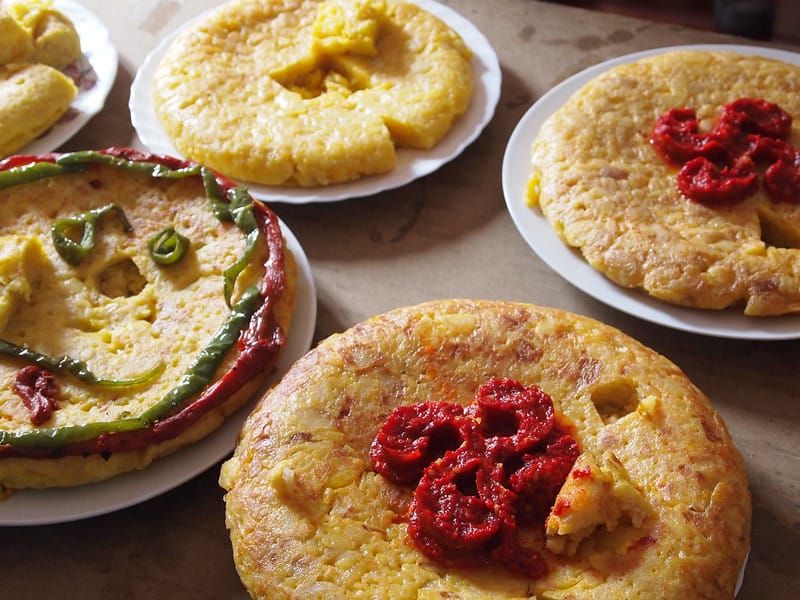

First course
Tortilla de patatas / Spanish omelette
This is the most well-known dish of the Spanish cuisine. It consists of a mixture of eggs, potatoes and onions that are pieced and fried in a frying pan together. Some people prefer tortilla de patatas with onion and others without it. Although it is delicious both ways, the traditional one has onion in it, so we recommend that you try this version.
If you go to a bar in Madrid or any other city in Spain, we will find tortilla de patatas portions or tortilla “pinchos” (with a slide of bread) for very little money.
👉 Recipe
Empanada gallega
Empanada is a typical dish or the region of Galicia, in the North of Spain. It is cooked with tuna, green and red pepper, and tomato. This mixture is put in a puff pastry dough, and baked for several minutes in the oven. This meal is usually served cold. You can find other versions with sardines or meat inside, let us know which one you liked best!
Patatas bravas
Patatas bravas are usually offered as a first course or a tapa in bars. The way it is cooked is by boiling potatoes and topping them with a slightly spicy sauce and paprika. Like tortilla de patatas, it is highly likely that you will find patatas bravas on the menu of almost any bar you visit during your stay in Madrid.


Sopa castellana
This soup is one of our favourites. It is a traditional dish in Castilla La Mancha in Spain. Its ingredients are: water, eggs, bread and garlic, and sometimes black pudding or chorizo is also added. It is usually eaten in winter because it is a heavy food and is served very hot. Note: If you don’t like undercooked eggs, let the waiter know when you order the food, because they usually do it that way, not the other way round.
Migas
Migas is also a typical dish of Castilla La Mancha. It is a very simple dish made in the past by the humble classes of society, who had little money to buy the food. The ingredients are: bread, water, chorizo and bacon, and sometimes grapes are added on top. It is cooked in a frying pan together, making it a very tasty dish.
Gazpacho andaluz y salmorejo cordobés
These two dishes are very similar, in both cases the main ingredient is tomato. Gazpacho is made with tomato, pepper, cucumber, vinegar and oil, to which several pieces of chopped cucumber or red and green pepper are added on top for presentation on the plate. The ingredients for cooking the salmorejo dish are tomato, bread, oil and garlic, to which boiled eggs, ham and pieces of stale bread are added on the plate.
Gazpacho is usually eaten as a kind of juice that you can drink, whereas salmorejo is eaten in a bowl with a spoon, due to its greater density. Both gazpacho and salmorejo are served cold.
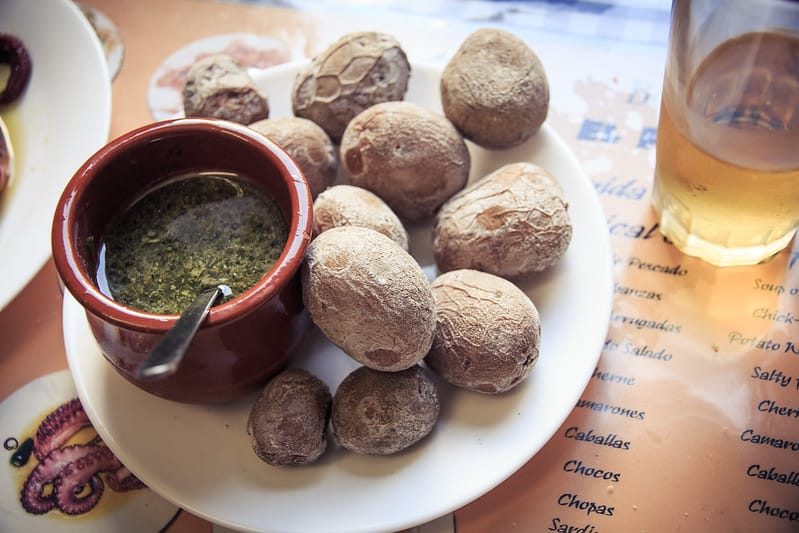

Papas arrugadas con mojo canario
The papas arrugadas, ‘papas arrugás’ or ‘papas arrugás con mojo picón’ is a typical dish from the Canary Islands. It is cooked by boiling small potatoes (‘papas’) in a bowl with water and salt until the water evaporates completely and the potatoes get wrinkled. When they are dry, chefs add a typical Canarian sauce, mojo, on top.
The mojo has garlic, pepper, cumin, paprika, vinegar, oil and salt, although it depends a lot on the person who prepares it. This sauce is a bit spicy, just to keep in mind in case you don’t like spicy food very much.
👉 Recipe.
Duelos y quebrantos
This dish appears in Don Quixote book! If Miguel de Cervantes liked it, we are sure we will love it! 😉 Duelos y quebrantos is a mixture of eggs, bacon and chorizo, that is cooked in a frying pan over a low heat. You can eat this typical Spanish dish in Castilla La Mancha.
Main course
Cocido madrileño
Cocido is the perfect meal in winter. It is typical in Madrid, although there are other versions in the north of Spain (cocido montañés, cocido lebaniego). It consists of two dishes: a first course with a soup and a second with vegetables, pulses and pieces of meat. All the ingredients are cooked together in a pressure cooker with water.
The vegetables that it contains are carrots, cabbage and turnip. The pulses are usually chickpeas, and the meat could be beef, pork and/or chicken. When cooked together, the food gets a very tasty and savoury flavour, and we highly recommend you try it if you travel to Madrid! In this link you will find some of the best restaurants where you can try cocido madrileño.
Moreover, if you visit Madrid and have some spare time, discover the Spanish culture and language joining our Spanish courses! (from 1 week).
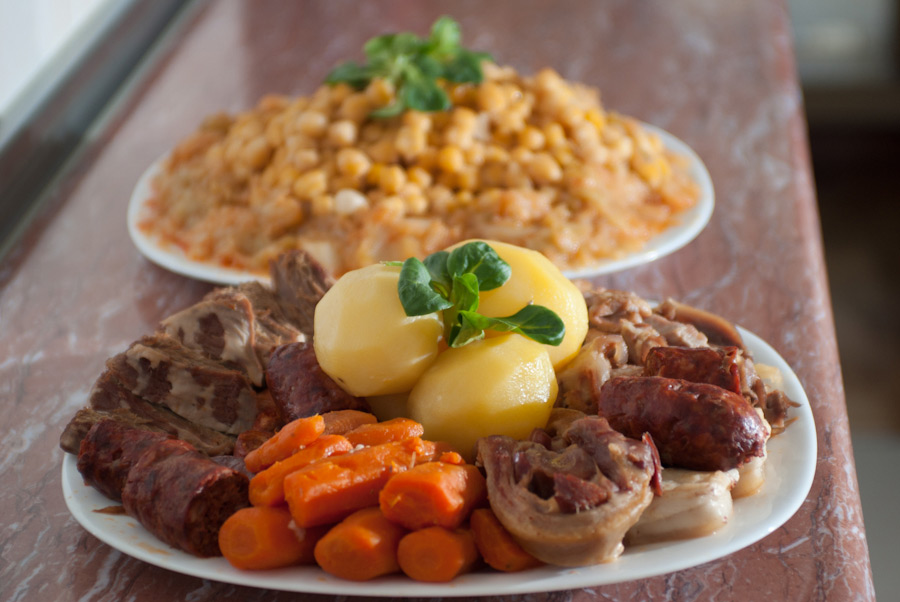

Fabada asturiana
Fabada is a traditional dish from Asturias, in the north of Spain. It is basically a stew with giant white beans, bacon, chorizo and morzilla. It is cooked with all the ingredients together. Likewise the cocido madrileño, fabada is a very fatty dish and it is best to order it between several people, otherwise you won’t be able to finish it. If it’s possible, try it in winter rather than in other seasons!
👉 Recipe.
Cachopo asturiano
Cachopo is a traditional Asturian dish. It consists of two veal fillets with cheese and Spanish cured ham inside and put together like a sandwich (but differently from the sandwich, instead of slices of bread, there are veal fillets 😂). Unless you eat a lot, share the cachopo dish with other person.
Paella valenciana
Another world-famous dish of the Spanish cuisine is paella. Paella is rice with seafood basically, which can be prepared in different ways. It usually contains clams, mussels, squid and prawns. The best paella is said to be found in Valencia and it has ‘socarrat’. Do you know what ‘socarrat’ is? It is the part of the rice that is burnt and is darker and crunchy when you eat it.
👉 Recipe.
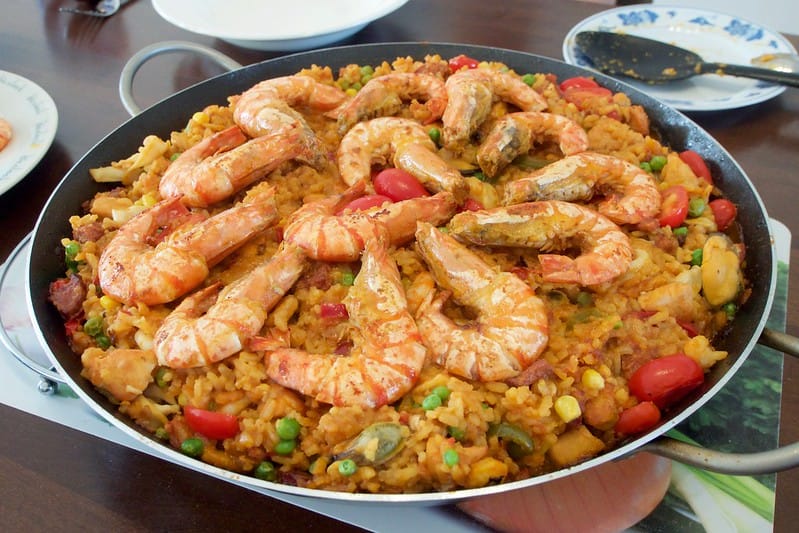

Cochinillo segoviano
A traditional dish from Segovia, in Castilla y León, just over an hour by train from Madrid is cochinillo. The traditional way of cooking cochinillo (suckling pig) is with the whole animal, and a mixture of garlic, lard, thyme, oregano and salt inside. This dish is placed in a wood-fired oven, over a clay tray with potatoes and bay leaves, and left there for several hours until the skin becomes crispy.
In Segovia we recommend you try this dish at Mesón de Cándido, where they cut the food with a plate, an original way of cutting it and which can only be achieved if the roast is perfect.
Pulpo a la gallega
Pulpo a la gallega or ‘pulpo á feira’ is other tasty dish of the Spanish gastronomy. In Galicia you will find many restaurants with dishes or tapas of this Galician-style octopus. The octopus is cooked, chopped and placed on mashed potatoes with paprika or with boiled potatoes and then sprinkled with coarse salt and olive oil. Just one word to describe the taste: delicious!
Desserts
Chocolate con churros
Hot chocolate with Spanish churros is one of the tourists’ favourite desserts when they visit our country. The chocolate is served hot in a cup, and in case you find it too sweet, you can have milk on it (say that you want a ‘chocolate vienés’). In Madrid the most famous place to have it is San Ginés, next to Plaza Mayor, Puerta del Sol and our school. 🙃
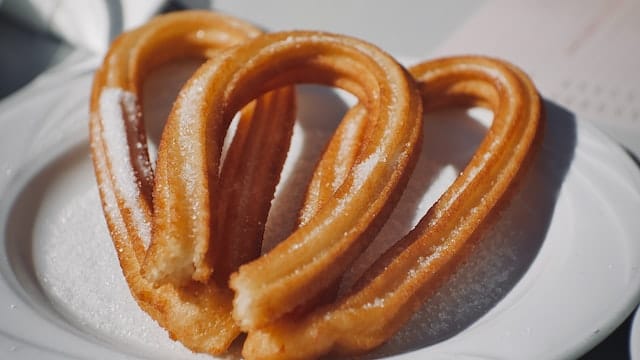

Torrijas
Torrijas are a seasonal dessert, that is, we usually eat it at Easter, although some people like them so much that they eat them at any time of the year. They are made with bread, beaten egg, milk, cinnamon and sugar. The bread is soaked in the milk and beaten egg, and then fried in a frying pan with a little amount of oil. Once fried, the slice of bread is coated in sugar and sprinkled with cinnamon, and left to cool. They are appetizing!
Crema catalana
Crema catalane has its origins in Cataluña (Catalonia) and is very sweet. It is made with custard that is covered with caramelised sugar, which gives it a very contrasting texture, soft on the inside and very crunchy on the outside. We usually eat it on National Father’s Day, March the 19th, although it can also be found in restaurants at any time of the year.


Filloas
This dessert is very similar to French crêpes and it is typical of Galicia, but also easy to find in Asturias and León. The dough is made with aniseed, the alcoholic drink, milk, flour, sugar and eggs. Inside you can find all kinds of fruits or sweet products such as ice cream, cream, chocolate, etc. Choose the flavour you prefer, you will probably love the result anyway!
👉 Recipe.
Natillas
Traditional natillas are made with eggs, cornstarch, sugar and lemon juice, among other ingredients, and has a very smooth texture. The dessert is usually topped with cinnamon powder and a Maria biscuit, to eat at the same time as the custard. Exquisite! We are getting hungry while writing down this!
Ensaimada mallorquina
The most delicious ensaimada you can eat in Spain is in Mallorca, in the Balearic Islands. It is a dough made with flour, water, sugar, pork dough and sourdough, baked and sprinkled with sugar. Be careful with your clothes when you try it! As the sugar tends to fall off as you bite it and you end up getting all your clothes white!
Roscón de Reyes
Roscón de Reyes is also eaten at a specific time of the year. In this case, at Christmas, on January the 6th. It is a sweet pastry topped with candied fruit and sugar. Sometimes it has cream, angel hair or truffle inside, despite the most common thing is that it has no filling and we dip it in melted chocolate.
Do you know why there is a bean inside? And why are there little dolls inside as well? As this dessert is eaten during the Christmas time, children enjoy looking for the little figures inside the roscón during the family breakfast. On the other hand, you will be lucky if you don’t find the bean! This is because the person who finds it is said to have to pay for the roscón.
Sobaos pasiegos
Sobaos pasiegos are typical of Cantabria, and more specifically of the area of Valle del Pas. The ingredients used to cook them are: sugar, eggs, yeast, butter, flour and lemon. If prepared well, they are really good, spongy and not too sweet. It is a delicious dessert to accompany a good coffee in the morning. 😋
We hope that you are much hungrier now that you have finished reading this post, and we are looking forward to seeing you in Madrid to try all these delicious dishes!



